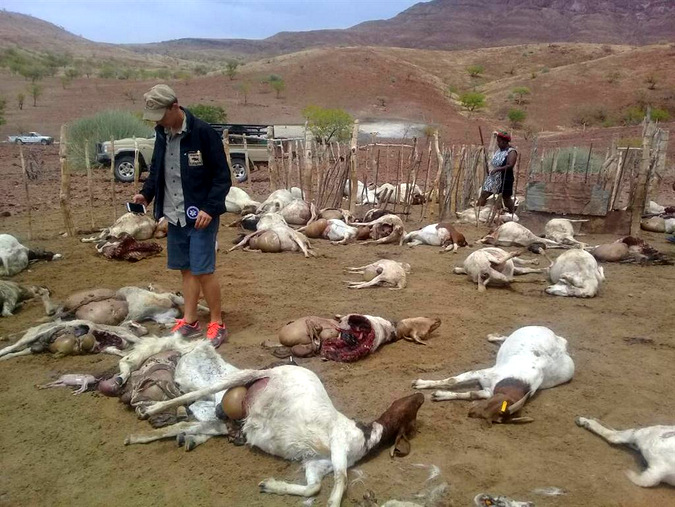
Sourced from various third-party sites: The Republikein, written by Francoise Steynberg, and The Namibian, written by Adam Hartman, and Facebook page of Izak Smit
Over 250 goats, sheep and donkeys have been killed by the same pride of 10-15 desert-adapted lions in Namibia’s Kunene region.
News just breaking, is that 171 goats and sheep were killed last night, with eight missing, just south of the first incident of last week (detailed below). The pride of desert-adapted lions (estimated 10-15 in number) roam the Etendeka Klipriver, Khoadi Hoas areas in arid north-western Namibia. Conservationist Izak Smit reported that these livestock were kept in old kraals that are not lion-proof. Smit lamented to Africa Geographic that attempts are being made to supply building material to make livestock safe from predators, but that lack of funds and feet on the ground is frustrating efforts. Smit noted that these losses are devastating for livestock farmers, who lose their entire livelihoods to lions, and that a solution has to be found to protect farmers and lions.
The first incident occurred on Wednesday last week, when a total of 86 goats and sheep, worth about N$150,000, were killed by the lions in a kraal belonging to one communal farmer.
The attack took place at Awantapos in the Torra Conservancy where farmer Samuel Gawiseb keeps his goats and sheep in a small kraal.
According to Gawiseb’s neighbour, Anthony Dawids, who saw the carnage, the farmer’s herder was alerted to the lions when a dog started barking. He stepped out and saw the lions at the kraal, but returned to the house as he could not risk his life with so many predators. His dog, however, was not fortunate and was also killed.
The lions managed to get into the kraal, killing the sheep and goats. Only 13 kids remained when the pride eventually left. “He suffered a serious loss. It was his entire livelihood, and how does one take care of the kids when the mothers are dead?” Dawids said.
He added that Gawiseb was in the process of modifying his kraal into a modern design, which would have had an 80% success rate in deterring lions from entering the kraal.
“Unfortunately, he was not done when the lions came. We are challenged here with these predators, and the impression is that the government and other organisations which deal with lions and human-wildlife conflict are not working hard enough to help,” Dawids lamented.
To comment on this story: Login (or sign up) to our app here - it's a troll-free safe place 🙂.![]()






